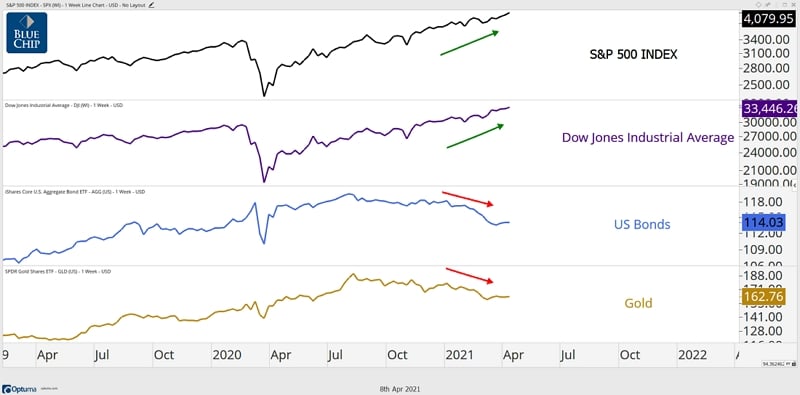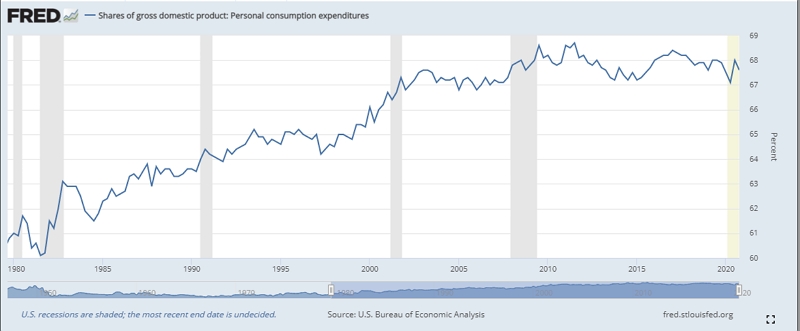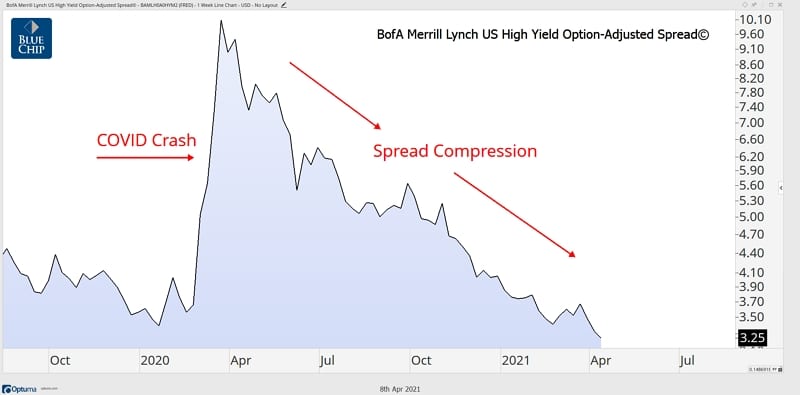Stocks Lead the Economy
The rally in stocks has perplexed many investors. How can stocks fare so well in an environment where the government is literally mailing out stimulus checks? According to The Conference Board, the S&P 500 is one of ten leading economic indicators That’s right, stocks lead future economic developments…typically by 9-12 months. If doom and gloom were imminent, investors today wouldn’t be hiding out in risky assets like stocks. Instead, they would be seeking out safe havens like bonds or gold. As you can see below, the S&P 500 and Dow Jones Industrial Average are breaking out to all-time highs while bonds and gold are selling off. These types of leading price developments suggest we are headed for a robust economic recovery in the back half of 2021.

Pent-Up Demand
On the heels of a historic election, many investors are worried about changes in legislation. In general, tax hikes are considered a headwind for stocks. However, those headwinds are being more than offset by the anticipated release of pent-up consumer demand as restrictions are lifted from the COVID vaccine. According to the U.S. Bureau of Economic Analysis, personal consumption has become more powerful over the years, accounting for nearly 70% of US Gross Domestic Product (GDP).

Think about it. We’ll book flights to visit friends. We’ll take trips to Disney with our kids. Cruises. Hotels. We’ll eat out at local restaurants (indoors!). While the consumer has spent online for the last year, we are ready to do it “in real life”. We’re ready for the pre-COVID normalcy many of us took for granted.
That being said, investors must be open to the possibility that the stock market could start cooling down just as the economy takes off in the second half of 2021. At that time, stocks will be looking forward well into 2022. But who knows, maybe 2022 will look bright. TBD.
Bonds Lead Stocks
While stocks lead the economy, bonds generally lead stocks. In fact, many refer to the bond market as “the smart money”. If a crash were imminent, we’d expect bonds of risky companies to be sold first. In this type of risk off environment, proceeds from junk bonds generally flow into safe-havens such as US Treasuries, leading to a widening of the yield spread between these bond types. Today, we’re seeing the opposite occur. Investors are buying junk bonds and selling US Treasuries, leading to spread compression. We’re keeping an eye out for a material change in spreads, which have historically been an early indicator for a sell-off in stocks.

Analyzing price as a leading indicator is simply one of the arrows in our quiver. Price developments are not always perfect, but they help us frame the edges of the investment puzzle. There’s one thing for certain, the Wall Street Journal and CNBC don’t have the answers. By the time a story hits the press the move in price is generally behind us, hence the saying “buy the rumor, sell the news”. It’s important to remember that the financial media exists to sell advertising, not to provide financial advice.
Expressions of opinion are as of this date and are subject to change without notice. The information provided does not constitute tax, legal, accounting, or other professional advice and is without warranty as to the accuracy or completeness of the information. Any information provided is not a complete summary or statement of all available data necessary for making an investment decision and does not constitute a recommendation to buy, hold or sell any security. The information has been obtained from sources considered to be reliable, but we do not guarantee that the foregoing material is accurate or complete. There are limitations associated with the use of any method of securities analysis. Indices are included for informational purposes only; investors cannot invest directly in any index. Every investor’s situation is unique, and you should consider your investment goals, risk tolerance and time horizon before making any investment. Prior to making an investment decision, please consult with your financial advisor about your individual situation. Past performance does not guarantee future results. Investing involves risk and you may incur a profit or loss regardless of strategy selected. There is no guarantee that any statements, opinions or forecasts provided herein will prove to be correct.

